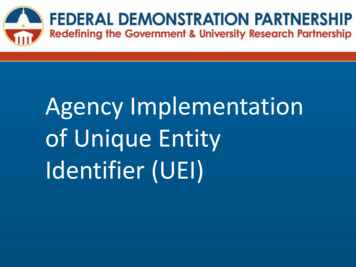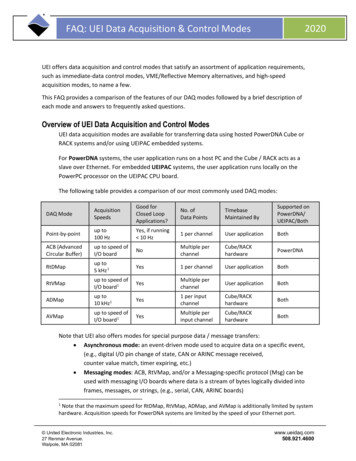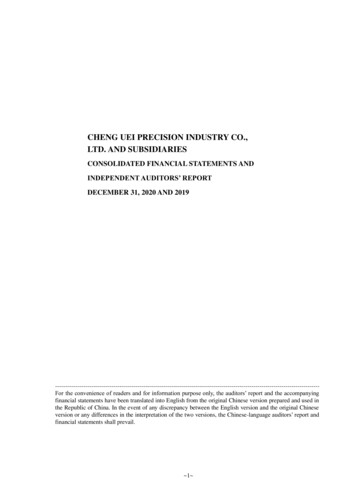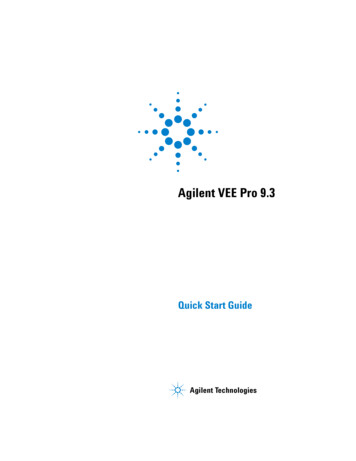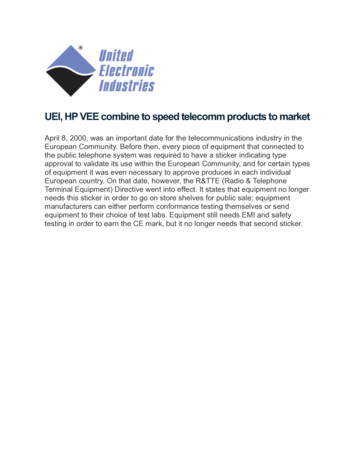
Transcription
UEI, HP VEE combine to speed telecomm products to marketApril 8, 2000, was an important date for the telecommunications industry in theEuropean Community. Before then, every piece of equipment that connected tothe public telephone system was required to have a sticker indicating typeapproval to validate its use within the European Community, and for certain typesof equipment it was even necessary to approve produces in each individualEuropean country. On that date, however, the R&TTE (Radio & TelephoneTerminal Equipment) Directive went into effect. It states that equipment no longerneeds this sticker in order to go on store shelves for public sale; equipmentmanufacturers can either perform conformance testing themselves or sendequipment to their choice of test labs. Equipment still needs EMI and safetytesting in order to earn the CE mark, but it no longer needs that second sticker.
Figure 1. An industrial PC populated with data-acq cards from United ElectronicIndustries forms the heart of the PSTN21 test stand from Genesys IBS Ltd. Thisrack of equipment allows users to check a wide variety of telecomm-relatedparameters and characteristics and thereby meet the exploding demand for testequipment arising from the European Community’s R&TTE Directive.As a resultof this dramatic shift in policy, the demand for inexpensive, flexible telecommtesters is about to mushroom as manufacturers look for ways to check their latestsystems at all phases of the development process. In addition, testing labs will belooking for equipment that allows them to not only conduct tests quickly but alsoto change over to test different types of devices. To fill this market gap, GenesysIBS Ltd (Monmouth, S Wales, UK) has developed the PSTN21 Test System (Fig.1), a PC-based test stand that relies heavily on PCI-bus data-acq cards fromUnited Electronic Industries (Watertown, MA, www.powerdaq.com). The systemcan test for a wide variety of telecomm-related parameters and characteristics.Among them are insulation resistance, ring signal characteristics, impedanceunbalance about earth, resistance to earth, equipment-under-test transient
performance, DC characteristics, sending-level limitations, spectral analysis, dialtone and call-progress tone recognition, DMTF dialing, loop disconnect (pulse)dialing, automatic calling and repeat attempts, and series connection. Thesystem comes with ISO 9001 calibration certificate. As an added bonus, aninternational “call progress tone database” comes preloaded with more than 400supervisory tones, and users also get a preloaded “ring signal database.”Besides taking single samples, the test stand can calculate measurementuncertainty information for each test, and a report generator saves testsummaries and data in Microsoft Office format.Need for flexibilityFrom this rather lengthy list of test types, it’s easy to see that this system requiresextreme flexibility. Thus the designers chose a PC platform along with generalpurpose data-acquisition cards. On top of a 748-mm high 19″ free-standing racksits a color monitor and keyboard. The rack incorporates an industrial-grade PCchassis along with specialized telecomm test equipment such as a seriallycontrolled matrix switch. When tests are running, though, a UEI card, the PD2MF-16-1M, handles most of the heavy lifting. The system multiplexes at most twoof the 12-bit analog inputs, which run at an aggregate rate of 1.2 MHz. Thiscapability meets the test stand’s requirement of sampling at 550 kHz/channel,which allows it to perform frequency analysis at ranges to 200 kHz. To handle theunusual conditions of the telecomm industry such as high-voltage ac and dccircuits, Genesys designed its own signal-conditioning front ends.The firm selected the UEI card, explains managing director Nick Evans, becauseit was the only one at the time that combined the required number of high-speedanalog inputs along with analog outputs and some digital I/O. Meanwhile, thenumber of digital I/O points the system requires has grown to exceeds 70, morethan the 16 inputs and 16 outputs on the PowerDAQ II card, so the designershave had to turn to an auxiliary board for that capability.
Figure 2. A graphical user interface that controls the underlying HP VEE programmakes it easy for test technicians to run existing tests, and being based on VEEalso allows design engineers to set up new tests with considerable ease andefficiency.The software that controls the test stand is written in HP VEE. Genesyschose that application-development environment for several reasons. First, theengineers felt that it gave them more productivity and the ability to writeprograms faster than other test-program environments. It’s also easy and fast totake a program written to address tests based on standards in one country andadapt that program to test against standards in other countries. Second, it allowsthem to write menu driven applications that are necessary because the end usersare oftentimes not familiar with the details of running telecomm tests (Fig. 2). Thesystem must be extremely easy to use because, thanks to the R&TTE Directive,people are getting into telephony without understanding everything that’s goingon in a piece of user equipment.Genesys’ development team did have to ask UEI to supply the source code forthe HP VEE drivers, which the card supplier was happy to do. The compiledversions, says Evans, placed too many restrictions on changing the card’ssampling rate programmatically. But when given the full source code, theengineers were able to quickly find a way to achieve the sample-rate flexibility
the test stand needs.
UEI, HP VEE combine to speed telecomm products to market April 8, 2000, was an important date for the telecommunications industry in the European Community. Before then, every piece of equipment that connected to the public telephone system was required to have a sticker indicating type
